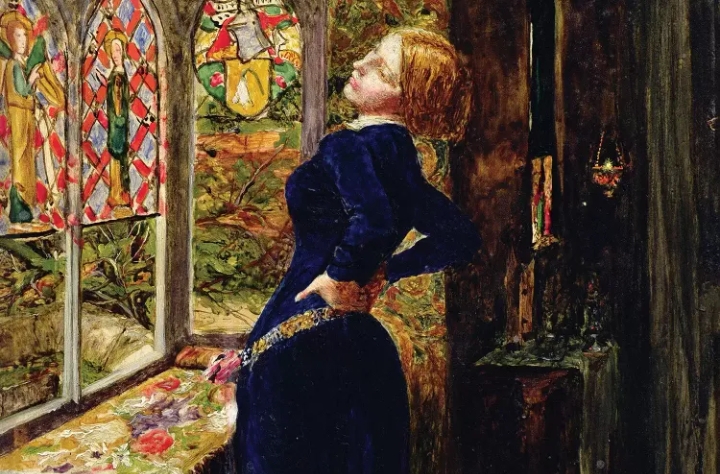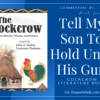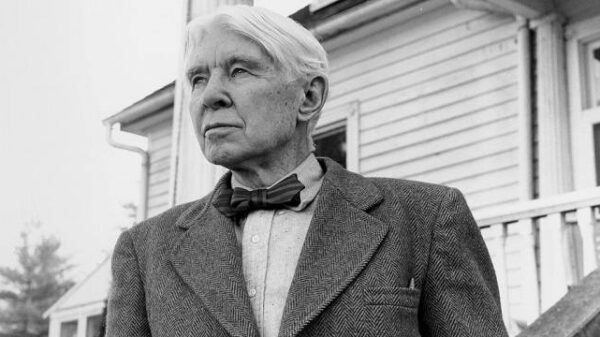Mariana was a poem that, as the writer, Alfred, Lord Tennyson put it, ‘arose to the music of Shakespeare’s words’ – the words Tennyson quotes as the poem’s epigraph. Or, to be more precise, misquotes: for where Shakespeare, in Measure for Measure, has the ‘dejected Mariana’ described as residing at the moated grange, Tennyson places Mariana in the moated grange, further underscoring her sense of confinement and isolation. In Shakespeare’s play, Mariana is residing in solitude because Angelo, the hypocritical ‘acting duke’ of Vienna (the real Duke has pretended to be called away on business, but actually hangs around in disguise, leaving Angelo in charge in his ‘absence’), has promised to marry her but then reneged on his promise, consigning her to lonely heartbreak at the grange.
Read Also: Summary, Structure & Commentary of ‘Crossing The Bar’, a Poem By Alfred, Lord Tennyson
In summary, Tennyson offers an insight into both Mariana’s physical life in her secluded grange and her psychological inner life, with many of the external details doubling as symbols for her psyche. Tennyson concludes each stanza with a similar refrain, in which Mariana is allowed to speak for herself, repeating how dreary and miserable her life is, and how she longs for death as a release from her dejected state. Angelo will not come (although in Shakespeare’s play – spoiler alert – he does eventually, in one of the Bard’s best-known ‘bed tricks’), and so there is no point in living any more: a feeling we have doubtless all had when in the throes of (especially adolescent) love. Mariana is doubly isolated: isolated because of her physical location (the grange where she dwells is ‘moated’ – an adjective echoed later in the poem by the ‘thick-moted sunbeam’, which even seems to mock her enclosure) but also because she has been cast out from life’s feast by being rejected by her would-be lover. Tennyson brilliantly conveys such double-isolation through the rhyme scheme for each stanza of ‘Mariana’, which runs ababcddcefef – effectively, a central couplet comprising enclosed rhymes (cddc) which is itself enclosed within a pair of couplets, one either side of it.
Read Also: Morte d’Arthur Written By Alfred, Lord Tennyson
But there’s more to it than this. As Tennyson’s great editor and biographer, Sir Christopher Ricks, observed in his excellent critical biography, Tennyson the language in those opening lines seems out to wrong-foot us:
With blackest moss the flower-plots
Were thickly crusted, one and all:
The rusted nails fell from the knots
That held the pear to the gable-wall.
The broken sheds look’d sad and strange:
Unlifted was the clinking latch;
Weeded and worn the ancient thatch
Upon the lonely moated grange.
Not ‘flower-pots’, note, but ‘flower-plots’; that clinking latch is ‘Unlifted’ rather than ‘Uplifted’, with the ‘un-word’, as in Thomas Hardy’s poetry, carrying the possibility of its opposite while also negating it (the latch would be lifted if Angelo only came; but he doesn’t). Such brilliant use of surprising or unexpected local detail continues later in the poem:
All day within the dreamy house,
The doors upon their hinges creak’d;
The blue fly sung in the pane; the mouse
Behind the mouldering wainscot shriek’d,
Or from the crevice peer’d about.
It was the modernist T. S. Eliot who observed, in his essay on Tennyson’s In Memoriam, that ‘The blue fly sung in the pane’ would lose its force if we substituted ‘sung’ for the more grammatically correct ‘sang’: ‘sung’ so brilliantly captures the deadened buzz of the trapped insect struggling to find a way out of the house, another poor creature who is imprisoned here, much like Mariana herself. (Tennyson once observed that he knew the quantities of vowel sounds in every English word – ‘except perhaps scissors’.) Eliot liked these lines from Tennyson’s poem so much that he borrows the image of the mouse in the wainscot for his ‘East Coker’ and ‘Little Gidding’, part of his Four Quartets.
Read Also: July in Washington a Poem By Robert Lowell
In summary, ‘Mariana’ was a mature poem to find among a poet’s first volume of poems published while he was still a student. The rest of the volume didn’t fare so well with many critics – the opening line of the poem ‘Lilian’ even gave us the phrase ‘airy fairy’ to describe something foolishly romantic and lacking substance – but ‘Mariana’ features in every good selection of Tennyson’s poems. Its images continue to repay close analysis, even though the poem itself carries a straightforward meaning. But, as so often with Tennyson, the devil is in the detail.
Cc: Deserved
Poet Nazir is a writer and an editor here on ThePoetsHub. Outside this space, he works as a poet, screenwriter, author, relationship adviser and a reader. He is also the founder & lead director of PNSP Studios, a film production firm.










